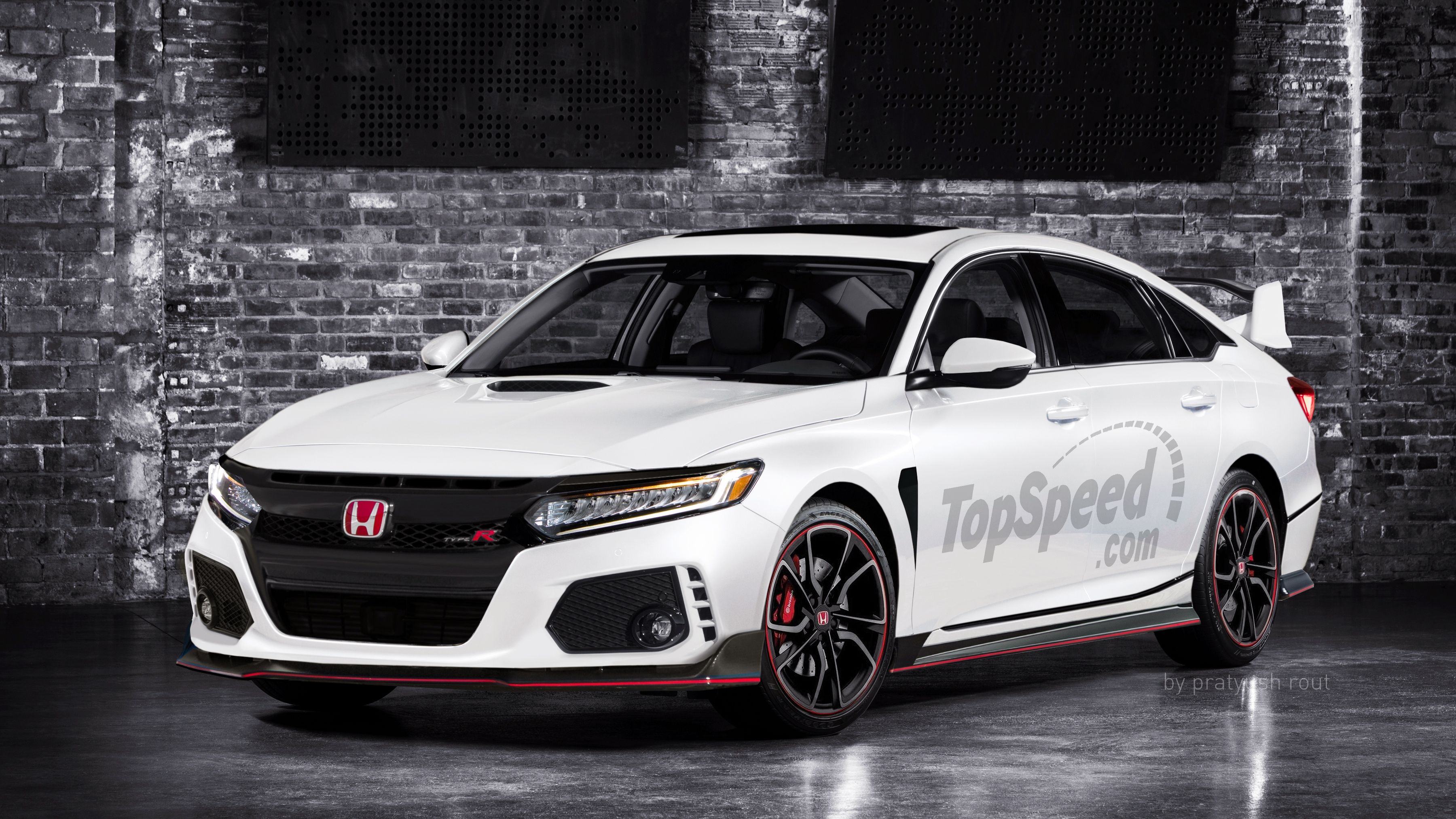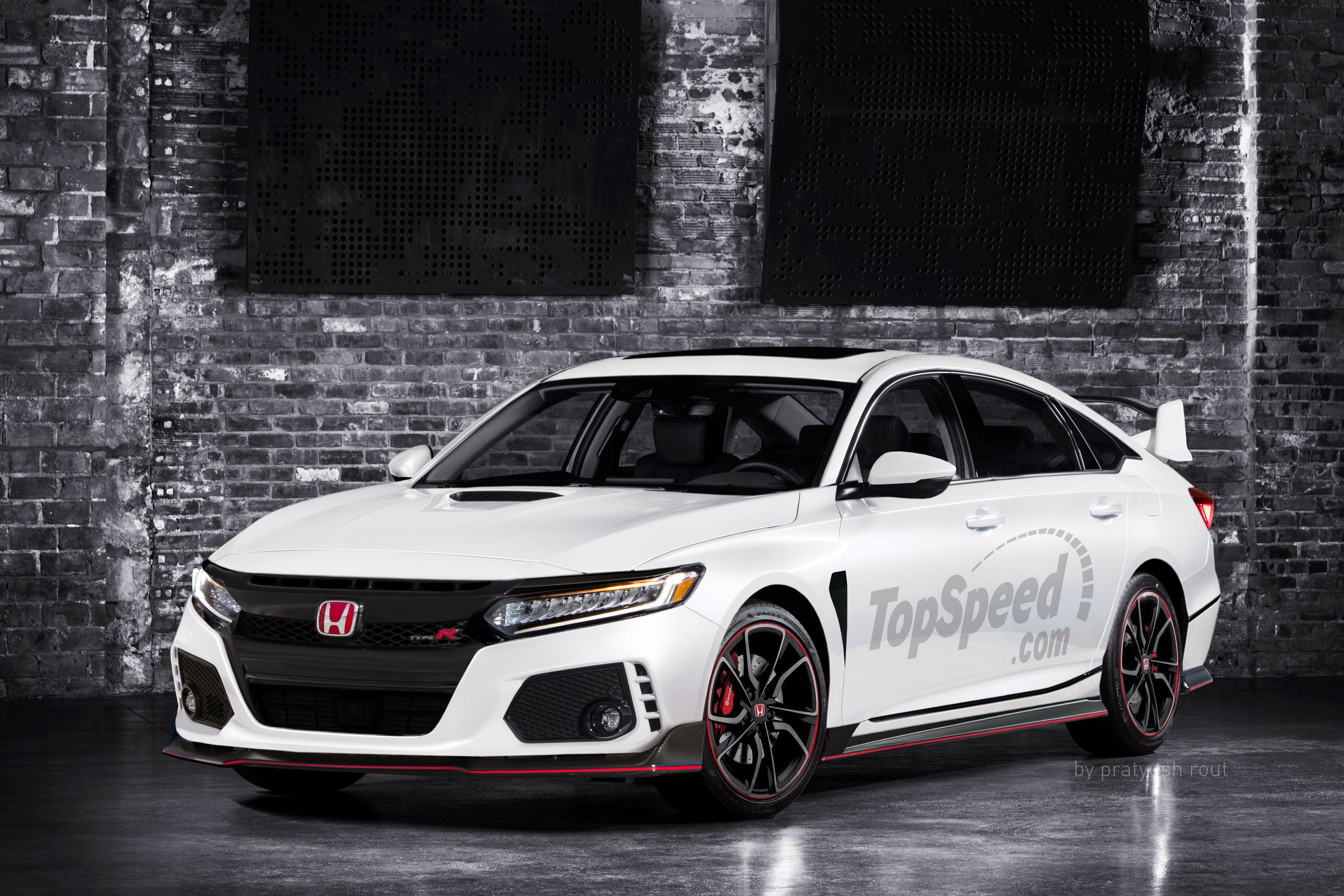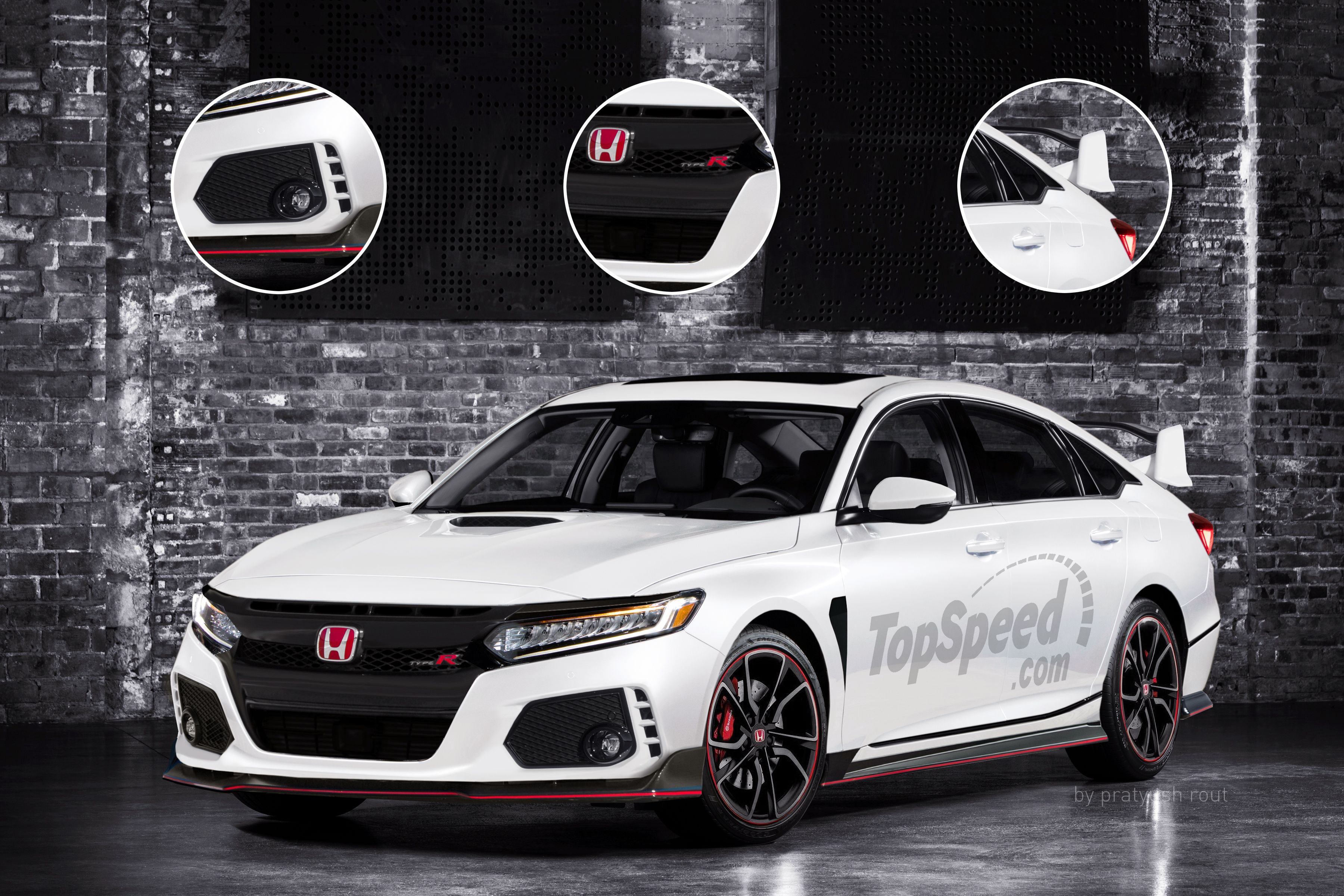There’s no denying that Honda has been pretty stingy when it comes to the Type R badge and the U.S. Market. Over the years, U.K., Euro, and Japanese markets always seemed to get the best that Honda had to offer, with the Type R badge being applied to the first-generation Acura NSX, Acura Integra, the Honda Accord and, of course, the Honda Civic. Of all these, the only models we saw come to the U.S. were the NSX Type R and the Integra Type R, both sporting Acura Badges, and we finally got the Civic Type R for the 2017 model year. With that in mind, it’s been a while since the world got a Type R version of the Accord, so we decided to render up was a U.S.-Spec Accord Type R would look like. Highlights of the build would include more aggressive fascias out front with Type R specific styling to go with plenty of Type R goodness inside. There would, of course, be an improved output over the range-topping model’s 252 ponies, but how that power will come to be is another story. Other necessities include a stiffer suspension, manual transmission, tuned-out exhaust, and a lower ride height.
On the plus side, all of the necessary prerequisites are already in play. The new Accord is pretty sporty on its own, so a more aggressive look should be easily welcomed. But, with the range-topping models of the Accord already sporting the detuned version of the Civic Type R’s 2.0-liter four-cylinder, it won’t take much to get some extra power to the wheels. Even more intriguing is the fact that Accord Sport models with the 2.0-liter can be equipped with a six-speed manual if you check the right option box, so you’ll be able to forgo dealing with that new 10-speed auto gearbox. With all of that in mind, let’s talk a little about the Accord Type R’s history and then take a good look at our rendering. Are you excited? I sure am. Let’s get to it…
2019 Honda Accord Type R
- Make: Array
- Model: 2019 Honda Accord Type R
- [do not use] Vehicle Model: Array
Accord Type R History
|
By Kreki87 (Own work) CC BY-SA 3.0, via Wikimedia Commons |
The new Accord in its best form at current offers up as much as 252 horsepower and 273 pound-feet of torque, which is, as a matter of fact, more powerful than any Type R Accord from the past. The first Accord Type R was produced from 1998 to 2002 and was sold solely in the U.K. and European market. At the same time, there was a JDM version called the Euro-R that used a different chassis and was found only in Japan. That model delivered a cool 209 horsepower and 164 pound-feet of torque from a 2.2-liter four-cylinder while it’s Euro equivalent delivered 217 horsepower.
These models all featured things like dual exhaust, stiffer suspension and chassis, larger wheels (17-inch,) and Xenon headlights on the outside while the inside got true-to-life Recaro seats and a Momo steering wheel. Customers often opted for an exterior spoiler on the rear deck that wasn’t only prominent but functional as well. This generation of the Accord Type R may have only lasted four years, and wasn’t even looked at as a great sports car because it was only available as a four-door sedan, but it did receive the most international awards among all of the basic Type Rs thanks to hose successful it was in the Euro Super Touring Cup in the late 1990s and early 2000s.
That short production run wasn’t the end for the Type R Accord, though. Honda didn’t waste any time at all and in 2002 came out with a successor that was based on the CL7 Accord platform. It was limited to the Euro and JDM markets and even offered a mild uptick in performance figures. The JDM model, specifically, used a 2.0-liter engine that was dubbed the K20A1 that was able to pump out 220 horsepower and 152 pound-feet of torque. Technology was limited back then and turbocharging wasn’t anywhere near as common from the factory, so maximum horsepower didn’t come into play until late in the powerband (8,000 rpm) while max torque came in at 7,000 rpm. To put that into perspective, the K20 engine redlined at 8,300 rpm. So, while the Accord Type R was able to deliver an increasing power output when put through the motions, it didn’t meet its full potential until late in the power band, making proper shifting exceptionally crucial when under the gun. This was also the same engine and configuration available in the Integra Type R at the time. This generation of the Accord Type R included the usual upgrades, including a limited-slip differential and double-wishbone independent suspension.
That “second-gen” Accord Type R was produced from 2002 to 2008 in Japan, and once it was discontinued at the end of the Accord’s seventh generation, the Type R badge has been missing from the lineup. But, we’re hoping Honda will look to the Civic Type R’s hype here in the U.S. and decide to honor us with a new Accord Type R. So, let’s take a look at that rendering now and talk more about it!
Exterior – The Type R goodness the 10th-Gen Accord Needs!
When Honda Introduced the 10th-generation Accord for the 2018 model year, it brought about a new design and fixed all of the Accords shortcomings from the previous generation. So, the Accord Type R, should it become a reality, will look a lot like the new Accord but will be much sportier in comparison to the standard model. Of course, the massive grille up front is here to stay, but it will be accented by the traditional Type R badge and the red Honda logo.
Down below, the smaller corner vents will be enlarged to mimic that of the Civic Type R. Of course, these are fake vents, so they are blocked off by plastic cladding, but they do give the Accord a more menacing appearance if you can look past the fakeness of it all. An extra lip will also reside at the bottom of the fascia which will help provide some frontal downforce but adds to the Type R look and provides those attractive little wings on the side of the fascia.
As you would expect, the Type R will be based on the range-topping model of the current lineup, so it will get the body-colored mirrors and a moonroof to go with the typical Type R hood vent as seen on the Civic Type R. Moving further back, we speculate that Honda will continue the lip along the side skirts and will even apply a thin pinstripe above them to add a little more character. The front fenders will get gloss black vents to match while the red striping of the Type R wheels will be accented by the red pinstripe on the body kit and the red brake calipers residing behind the wheels.
We chose not to render the rear end of the Accord, as logic – and Honda’s current design philosophy – tells us that the rear fascia will mimic the front, just like on the Civic Type R. Expect to see a pair of big fake vents to go with a diffuser that is garnished by centrally mounted exhaust outlets that are tied into the true dual exhaust. The taillights should be the same but will be a little more tinted and should feature some gloss black accenting to help tie things together. Finally, the rear deck will be fitted with a massive spoiler that’s more aesthetic than anything but still functional at the same time. All told, a Type R Accord would maintain all of the goodness from the 10th-gen model, but kick things up a notch in the aggression department. But, that’s not all that would change if it does become a reality. Let’s take a look at what the interior might offer.
Interior – It’s Not Your Grandma’s Accord, but It’s Not a Dream Either
|
Interior of 2017 Honda Civic Type R |
Now, back in the day, the Type R badge meant that you got lots of aftermarket goodies inside too, including an aftermarket steering wheel and racing seats. Now, the market and automotive climate are a little different, so you won’t be getting any aftermarket goodies. Instead, Honda does it all on their own, which is pretty commendable considering just how sporty the front seats in the Civic Type R really are.
As such, expect to find all Honda equipment inside that includes new sports seats with ample bolster support and holes for a five-point harness. There should also be an aluminum shift knob and short-throw shifter to go with tons of red accents. You’ll get red stitching on all fabric while the front seats should be made from suede. The dash will get some red pin striping while the Honda steering wheel will get red accents between the spokes. There should also be a decent dose of carbon fiber here and there to go with some suede trim inserts and red seatbelts for all seats front and rear.
|
Rear seat of 2017 Honda Civic Type R |
The red accenting isn’t surprising at all. Red has been used as an accent color for the better part of three decades, all starting with the traditional red Honda emblem on all Honda Type R models. It’s only fitting that the inside, then, also gets red accenting to match the accents outside this beauty. Of course, this is the 10th-gen Accord we’re talking about, so the lack of aftermarket accessories isn’t exactly a bad thing either.
With the new-gen model, Honda addressed a lot of problems with previous models. The two-screen display setup is gone in place of a single display that hovers ahead of the center stack. The Type R variant would get the eight-inch infotainment display to go along with the seven-inch instrument cluster display. Backlighting for both of these displays, as well as backlighting in the rest of the car, should feature the Type R red that we all know and love. The infotainment system will also get its own unique software to help make it stand out and provide some track-specific goodies like a lap and sprint timer, for instance.
|
Interior from base 2018 Honda Accord |
As far as other goodies go, you’ll most likely get the six-inch head-up display, a 4G-LTE internet connection with hotspot and OTA software updates. In the audio department, Honda will go with the best system available which happens to be a 450-watt, 10-speaker system with dual 2.5-amp USB ports and plenty of bass if you’re into going thump. All interior dimensions should remain the same, which means you’ll still get the standard 16.7 cubic-feet of cargo space and 105.6 cubic-feet of passenger volume – enough for five people.
Drivetrain – The Motivating Factor Behind Your Manhood
|
2.0-liter i-VTEC from 2017 Honda Civic Type R |
The 10th-gen Accord is currently offered with a 1.5-liter in base trim that’s good for 192 horsepower and 192 pound-feet of torque, while the upper trim levels get a 2.0-liter that’s good for 252 horsepower and 273 pound-feet of torque. Of course, while that 2.0-liter is the same engine used in the Civic Type R, that kind of output isn’t good enough for something with a Type R badge, which is exactly why it was uprated for the Civic Type R. Now, Honda initially took a lot of crap for the 2.0-liter in the Civic because it’s rated at just 306 horsepower (the same rating from the previous-gen model) and 295 pound-feet of torque. Now, maximum horsepower comes in a 6,500 rpm and torque comes in at 7,000 rpm. And, now that there’s no V-6 offering for the Accord, you can bet the Accord will get the same uprated version of that 2.0-liter.
Expect it to deliver the same power output in the Accord. The reason behind this is the same reason why Honda didn’t offer up enough for the Civic to beat out the Focus RS – it all comes down to reliability. And, in one sense, that’s a good consideration to have as pushing too much from four cylinders does tend to hamper reliability quite a bit.
The Type R Accord will get the same short-throw six-speed to handle shifting gears, but it’s quite possible that Honda could go with an AWD drivetrain for the Type R which would be nice, but isn’t very likely considering the Civic Type R is also limited to FWD. Sprint times for the 10th-gen Accord aren’t out quite yet, but with the Civic able to hit 60 mph in 4.9 seconds and a top speed of 169 mph, expect the Accord Type R to make the same sprint in around 5.5 seconds while top speed could remain the same or drop down to 165 mph at most. It won’t be too bad for an Accord, but with any luck, Honda will come up with a way to make the Type R variant a little bit quicker. Maybe some kind of weight reduction or even a larger four-cylinder. Hell, it could even go all out, and use the upcoming Accord Hybrid as a basis for the Type R and massage it to deliver more like 350 ponies. But, we’ll just have to wait and see what Honda does, should it decide to take the Type R route.
Pricing
Throwing a Type R badge on the Accord won’t come cheap for Honda, and that means it won’t come cheap for you either. Honda has yet to release pricing for the 2018 Accord, but the 9th-gen model is going for $34,930 in the range-topping Touring trim level. Of course, that model gets all of the fixins’ including navigation, Honda Sensing, LED lights, heated seats, etc. It also has a V-6 that is completely obsolete for the 10th-gen model. Be that as it may, the Touring trim isn’t likely to come down in pricing as it runs about average in the segment at the time of this writing, so a Type R should come in somewhere around $43,000 to $47,000 depending on any price increase seen with the official arrival of the 10th generation.
Competition
Ford Fusion Sport
Unfortunately, the Accord Type R would pretty much sit in a niche all by itself at this point. With that said, the closest competitor you could really look to would be the Ford Fusion Sport. It may not be quite as aggressive looking, and may not have as much flare as anything with a Type R badge, and it isn’t even offered with a manual transmission, but it does come with decent power on tap. Under the hood, you’ll find Ford’s 2.7-liter V-6 that’s good for 325 ponies and 380 pound-feet of torque. Clearly, this is more than what I’m estimating for the Accord Type R, but shifting duties are also handled by a six-speed automatic with paddle shifters, so it’s not exactly a driver’s car either. It comes complete with all-wheel drive, quad exhaust outlets, and direct fuel injection. In the end, it’s also cheaper as well, with pricing at the time of this writing coming to $33,750 before options, taxes, and destination charges.
Read our full review on the Ford Fusion Sport.
Conclusion
One has to admit that an Accord Type R making a presence again would be pretty amazing, and the fact that it could come to the U.S. would be even better, but there’s an important factor to remember here – there aren’t too many cars that would really stack up against it, and therefore would be a hard sell to the bean counters over at Honda. That doesn’t mean that it won’t happen, but the likelihood isn’t all that great unless a true demand for such a car is really shown from the general public.
On top of that, Honda may need to come up with a solution for the drivetrain as using the Civic Type R’s engine with the same output rating could be perceived as lazy, and wouldn’t really do the Accord a lot of justice as it would be slower than the Civic still. Now, if Honda chose to go with a hybrid drivetrain, that could work and offer up a decent amount of power, or it could offer a turbocharged V-6 that’s exclusive to the Accord Type R. Again, that could be costly, but it might not be that bad if Honda went with the same V-6 from the 9th-gen Accord and gave is some serious tweaking and a pair of turbos.
For now, it’s all speculation but what do you guys think? Should Honda green light an Accord Type R or are we reaching a bit much hoping for such a thing? Let us know in the comments section below.
References
Honda Accord
Read our full review on the Honda Accord.
Honda Civic Type R
Read our full review on the Honda Civic Type R.
Read up on the latest Type R News










